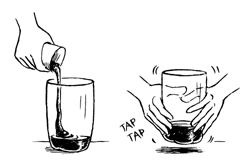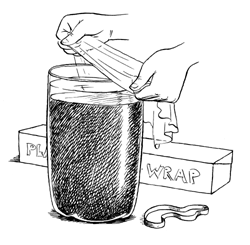Mysterious Life of Caves
|  |
Student Handout |
Microbial Townhouse
Researchers are finding that microorganisms can live
in places they never expected, like deep in the ocean
or far below Earth's surface in caves where sunlight fails to penetrate or where poisonous gases exist.
In this activity, you will see how microorganisms can develop in different environments depending on what they need to live.
Procedure
Begin by ripping a newspaper square into tiny bits. Crack the hard-boiled egg and break the yolk into bits. Discard the white and the shell. Combine the mud and just enough water in the bucket to make a thick mud soup. Use the spoon to mix thoroughly. When the mud and water are combined, stir in the newspaper, egg yolk, and chalk.

Add the mixture to the bottle with a paper cup to one inch from the top. Tap the bottle on the table between additions to remove air bubbles. Let stand for 30 minutes. Gently add enough water so that there is a top layer of water about a half-inch deep above the mud surface. Cover the top of the bottle with plastic wrap and secure with the rubber band. The gas produced by the microorganisms is very smelly, so keep the plastic wrap on at all times.

Stand your bottle either in a well-lit place or in a dark place as directed by your teacher. Do not move the bottle. Do not let the bottle dry out. Add or remove water to the top to maintain the half-inch depth. Observe and record changes with sketches and descriptions each day for six weeks. After the six-week period is over, answer the questions below.
Questions
Write your answers on a separate sheet of paper.
Did any changes occur in the bottle? If so, what is your evidence? How many different life forms seem to exist? Propose an explanation for the existence of the different things that you see in the bottle.
|